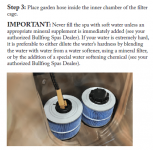We got a Bullfrog A8 last year and we included the ozone unit. We use the frog@ease cartridge system. First time we filled it with straight well water from the outside spigot, with a hose-end filter. Seemed like it took several weeks to get the chemistry right with metal remover, phosphate remover, really low free chlorine etc.
Our well water has 1-3 ppm iron but has a lot of sulfates and both iron and sulfate reducing bacteria which caused a lot of rotten egg smell in the house water. As a result we had an IC storm ozone unit installed before our water softener. This really helped.
The last time I drained and filled the tub I used half straight well water and half soft water from an inside faucet which I ran out the window with a hose. This seemed to work well.
I was thinking of having the spigot by the hot tub changed so it came off the treated water lines and not straight from the well. However I’ve read you are not supposed to fill totally with soft water. Is this true? I’m also wondering if I could have the hot tub spigot come from the IC storm (iron/sulfate treated water) before it goes through the softener, at least to eliminate some of those problems. Thoughts?
Our well water has 1-3 ppm iron but has a lot of sulfates and both iron and sulfate reducing bacteria which caused a lot of rotten egg smell in the house water. As a result we had an IC storm ozone unit installed before our water softener. This really helped.
The last time I drained and filled the tub I used half straight well water and half soft water from an inside faucet which I ran out the window with a hose. This seemed to work well.
I was thinking of having the spigot by the hot tub changed so it came off the treated water lines and not straight from the well. However I’ve read you are not supposed to fill totally with soft water. Is this true? I’m also wondering if I could have the hot tub spigot come from the IC storm (iron/sulfate treated water) before it goes through the softener, at least to eliminate some of those problems. Thoughts?


